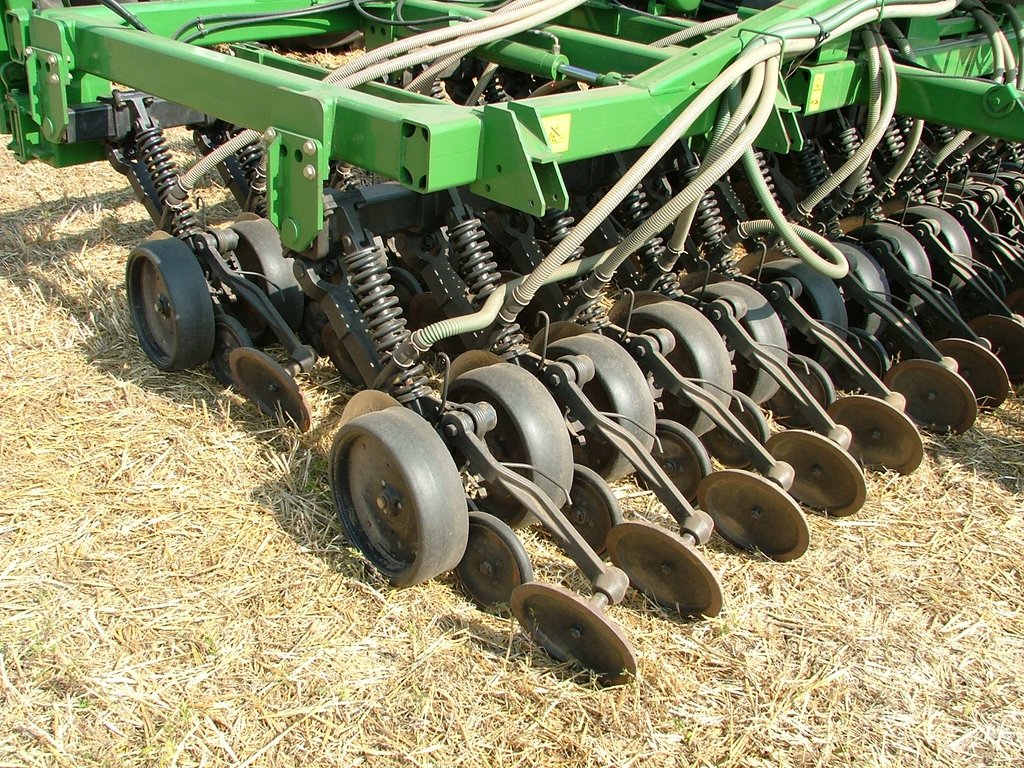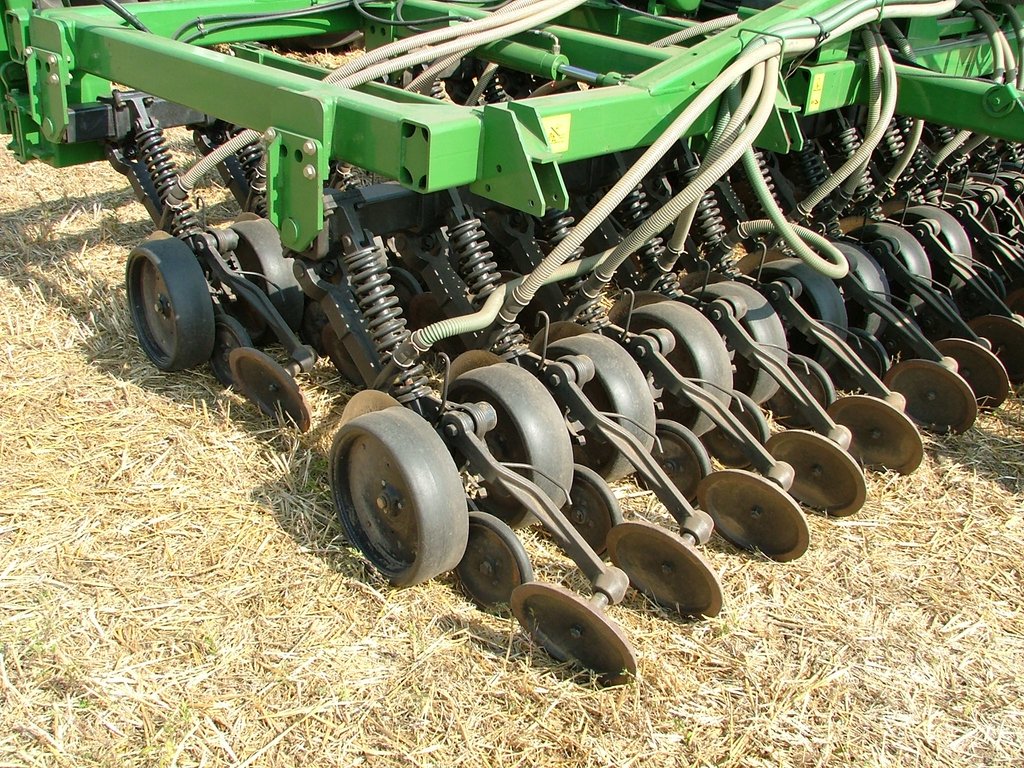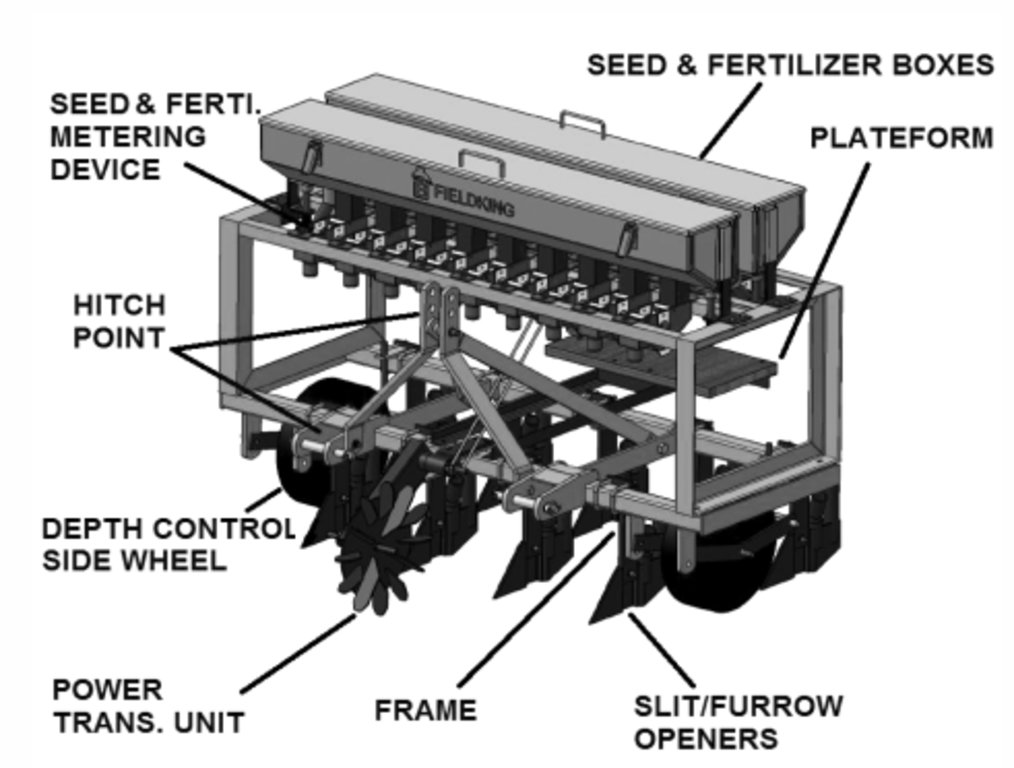No-till agriculture [Hungary]
- Creation:
- Update:
- Compiler: Brigitta Szabó
- Editors: Piroska Kassai, Zoltan Toth
- Reviewers: William Critchley, Rima Mekdaschi Studer
művelés nélküli direktvetés
technologies_6199 - Hungary
View sections
Expand all Collapse all1. General information
1.2 Contact details of resource persons and institutions involved in the assessment and documentation of the Technology
Key resource person(s)
land user:
Ferenc Berend
Berend Kft
Hungary
Name of project which facilitated the documentation/ evaluation of the Technology (if relevant)
OPtimal strategies to retAIN and re-use water and nutrients in small agricultural catchments across different soil-climatic regions in Europe (OPTAIN)Name of the institution(s) which facilitated the documentation/ evaluation of the Technology (if relevant)
Institute for Soil Sciences, Centre for Agricultural Research (ATK TAKI) - Hungary1.3 Conditions regarding the use of data documented through WOCAT
The compiler and key resource person(s) accept the conditions regarding the use of data documented through WOCAT:
Yes
1.4 Declaration on sustainability of the described Technology
Is the Technology described here problematic with regard to land degradation, so that it cannot be declared a sustainable land management technology?
No
1.5 Reference to Questionnaire(s) on SLM Approaches (documented using WOCAT)

Zero Tillage [China]
Zero tillage approach was developed to protect the soils from sealing rainfall, to achieve and maintain a open internal soil structure, to enhance biological processes in the soil, and to develop a means for safe disposal of any surface runoff that nevertheless will occur.
- Compiler: Zhanguo Bai
2. Description of the SLM Technology
2.1 Short description of the Technology
Definition of the Technology:
No-till agriculture replaces conventional soil tillage in order to reduce costs and labour - and to provide a mulch layer on the soil surface from the residues of the previous crop: this protects the soil surface and its ecology.
2.2 Detailed description of the Technology
Description:
No-till agriculture is applied on arable land, principly for cereals and oil seed grains. It is not suitable for root and tuber crops. Crops are sown by a direct drilling machine capable of placing seeds into undisturbed soil. The soil surface is covered by the residues of the previous crop. There is no soil distubance by tillage as in conventional ploughing and harrowing.
The purpose is to reduce costs and labour requirements and to provide a mulch layer on the surface that creates better soil protection. Changing to no-till from conventional tillage requires the purchase or hire of a special direct drilling machine, and a higher performance tractor is also usually needed.
As a consequence of the adoption of no-till agriculture due to zero soil disturbance, soil microbes and mesofauna (very small invertebrates) are also undisturbed. Soil aggregates are more stable and the tunnel systems of mesofauna and earthworms result in good water infiltration. In addition – due to the mulch cover on the surface – the speed of runoff water is reduced or eliminated, and fewer pollutants reach watercourses.
Under zero tillage systems, mechanical pest and weed control cannot be used, so more intensive chemical weed and pest control is needed, resulting in a potential environmental hazard. Furthermore, as a result of continuous mulch cover, zero soil disturbance and high biodiversity in the soil, wildlife are attracted to these fields to feed on snails, worms and larvae which can cause damage to the crops.
The establishment of the technology is expensive in the short term (purchase of the machines) and yields will decrease significantly. However, labour and other costs (fuel for example) will drop. These turns running cost into positive in the long term again and establishment/ investment costs will also be positive (comparing to conventional tillage system.)
2.3 Photos of the Technology
2.4 Videos of the Technology
Comments, short description:
no video is uploaded
2.5 Country/ region/ locations where the Technology has been applied and which are covered by this assessment
Country:
Hungary
Region/ State/ Province:
Somogy County
Further specification of location:
Vityapuszta
Specify the spread of the Technology:
- applied at specific points/ concentrated on a small area
Is/are the technology site(s) located in a permanently protected area?
No
Map
×2.6 Date of implementation
Indicate year of implementation:
2010
2.7 Introduction of the Technology
Specify how the Technology was introduced:
- through land users' innovation
Comments (type of project, etc.):
The land user (a farmer) implemented the technology based on his personal experience in the USA as a farm worker.
3. Classification of the SLM Technology
3.1 Main purpose(s) of the Technology
- reduce, prevent, restore land degradation
- conserve ecosystem
- reduce risk of disasters
- adapt to climate change/ extremes and its impacts
- create beneficial economic impact
3.2 Current land use type(s) where the Technology is applied
Land use mixed within the same land unit:
No

Cropland
- Annual cropping
Annual cropping - Specify crops:
- cereals - barley
- cereals - maize
- cereals - wheat (winter)
- seed crops - sesame, poppy, mustard, other
- sunflower
Number of growing seasons per year:
- 1
Is intercropping practiced?
Yes
If yes, specify which crops are intercropped:
mixture of different covercrop species
Is crop rotation practiced?
Yes
If yes, specify:
winter wheat, maize, sunflower
3.3 Has land use changed due to the implementation of the Technology?
Has land use changed due to the implementation of the Technology?
- No (Continue with question 3.4)
3.4 Water supply
Water supply for the land on which the Technology is applied:
- rainfed
3.5 SLM group to which the Technology belongs
- minimal soil disturbance
3.6 SLM measures comprising the Technology

agronomic measures
- A1: Vegetation/ soil cover
- A3: Soil surface treatment
A3: Differentiate tillage systems:
A 3.1: No tillage
3.7 Main types of land degradation addressed by the Technology

soil erosion by water

physical soil deterioration
- Pc: compaction
- Pk: slaking and crusting

biological degradation
- Bs: quality and species composition/ diversity decline
- Bl: loss of soil life
3.8 Prevention, reduction, or restoration of land degradation
Specify the goal of the Technology with regard to land degradation:
- reduce land degradation
- restore/ rehabilitate severely degraded land
4. Technical specifications, implementation activities, inputs, and costs
4.1 Technical drawing of the Technology
Technical specifications (related to technical drawing):
Sowing/ drilling is done on undisturbed soil surface covered by mulch. The direct drilling machine cuts through the mulch on the top of the soil, opens a slit where the seeds are placed in the required depth and spacing, then the slot is opened, so soil surface remain 100% covered by mulch. The direct driller machines usually requires higher performance tractors than the conventional sowing/drilling machines
Source: https://www.fieldking.com/images/pdfs/zero-till.pdf
Author:
https://www.fieldking.com/images/pdfs/zero-till.pdf
4.2 General information regarding the calculation of inputs and costs
Specify how costs and inputs were calculated:
- per Technology area
Indicate size and area unit:
ha
Specify currency used for cost calculations:
- USD
Indicate average wage cost of hired labour per day:
50
4.3 Establishment activities
| Activity | Timing (season) | |
|---|---|---|
| 1. | buying direct driller machine | machine is used for 10 years (450 ha/year) |
Comments:
New direct drilling machine is used for 10 years. Average annually sowed/drilled area is 450 ha. Price of machine is ca. 130 000 USD, thus specific extra cost per ha is 30 USD compared to the conventional sowing/drilling machine.
4.4 Costs and inputs needed for establishment
| Specify input | Unit | Quantity | Costs per Unit | Total costs per input | % of costs borne by land users | |
|---|---|---|---|---|---|---|
| Equipment | cost of direct drilling machine per ha | ha | 1.0 | 30.0 | 30.0 | 100.0 |
| Total costs for establishment of the Technology | 30.0 | |||||
| Total costs for establishment of the Technology in USD | 30.0 | |||||
If you are unable to break down the costs in the table above, give an estimation of the total costs of establishing the Technology:
130000.0
Comments:
New direct drilling machine is used for 10 years. Average annually sowed/drilled area is 450 ha. Price of machine is ca. 130 000 USD, so specific extra cost per ha is 30 USD compared to the conventional sowing/drilling machine. Parallel with the application of no tillage there is a reduction in tillage costs ca. 100-120 USD.
4.5 Maintenance/ recurrent activities
Comments:
No extra costs applies compared to conventional agricultural technologies
4.6 Costs and inputs needed for maintenance/ recurrent activities (per year)
Comments:
No extra costs applies compared to conventional agricultural technologies. There is a reduction in tillage costs ca. 100-120 USD.
4.7 Most important factors affecting the costs
Describe the most determinate factors affecting the costs:
An extra cost of 30 USD/ha applies, when implementing new direct driller machine, while in the same time 100-120 USD/ha reduction happens in tillage costs. Labour hours is also reduced to as low as 25-30% of conventional technologies.
5. Natural and human environment
5.1 Climate
Annual rainfall
- < 250 mm
- 251-500 mm
- 501-750 mm
- 751-1,000 mm
- 1,001-1,500 mm
- 1,501-2,000 mm
- 2,001-3,000 mm
- 3,001-4,000 mm
- > 4,000 mm
Specifications/ comments on rainfall:
distribution is uneven
Agro-climatic zone
- sub-humid
50 yr (1951-2000) annual mean precipitation is 653 mm. 50 yr (1951-2000) annual mean temperature is 10,4 oC based on meteorology station in Keszthely.
5.2 Topography
Slopes on average:
- flat (0-2%)
- gentle (3-5%)
- moderate (6-10%)
- rolling (11-15%)
- hilly (16-30%)
- steep (31-60%)
- very steep (>60%)
Landforms:
- plateau/plains
- ridges
- mountain slopes
- hill slopes
- footslopes
- valley floors
Altitudinal zone:
- 0-100 m a.s.l.
- 101-500 m a.s.l.
- 501-1,000 m a.s.l.
- 1,001-1,500 m a.s.l.
- 1,501-2,000 m a.s.l.
- 2,001-2,500 m a.s.l.
- 2,501-3,000 m a.s.l.
- 3,001-4,000 m a.s.l.
- > 4,000 m a.s.l.
Indicate if the Technology is specifically applied in:
- not relevant
5.3 Soils
Soil depth on average:
- very shallow (0-20 cm)
- shallow (21-50 cm)
- moderately deep (51-80 cm)
- deep (81-120 cm)
- very deep (> 120 cm)
Topsoil organic matter:
- medium (1-3%)
5.4 Water availability and quality
Ground water table:
5-50 m
Availability of surface water:
medium
Water quality (untreated):
for agricultural use only (irrigation)
Water quality refers to:
surface water
Is water salinity a problem?
No
Is flooding of the area occurring?
No
5.5 Biodiversity
Species diversity:
- medium
Habitat diversity:
- high
Comments and further specifications on biodiversity:
hills, valleys, grass, forest, arable land mixed
5.6 Characteristics of land users applying the Technology
Sedentary or nomadic:
- Sedentary
Market orientation of production system:
- commercial/ market
Off-farm income:
- less than 10% of all income
Relative level of wealth:
- average
Individuals or groups:
- individual/ household
Level of mechanization:
- mechanized/ motorized
Gender:
- men
Age of land users:
- middle-aged
5.7 Average area of land used by land users applying the Technology
- < 0.5 ha
- 0.5-1 ha
- 1-2 ha
- 2-5 ha
- 5-15 ha
- 15-50 ha
- 50-100 ha
- 100-500 ha
- 500-1,000 ha
- 1,000-10,000 ha
- > 10,000 ha
Is this considered small-, medium- or large-scale (referring to local context)?
- large-scale
5.8 Land ownership, land use rights, and water use rights
Land ownership:
- individual, not titled
- individual, titled
Land use rights:
- leased
- individual
Water use rights:
- communal (organized)
Are land use rights based on a traditional legal system?
Yes
5.9 Access to services and infrastructure
health:
- poor
- moderate
- good
education:
- poor
- moderate
- good
technical assistance:
- poor
- moderate
- good
employment (e.g. off-farm):
- poor
- moderate
- good
markets:
- poor
- moderate
- good
energy:
- poor
- moderate
- good
roads and transport:
- poor
- moderate
- good
drinking water and sanitation:
- poor
- moderate
- good
financial services:
- poor
- moderate
- good
6. Impacts and concluding statements
6.1 On-site impacts the Technology has shown
Socio-economic impacts
Income and costs
expenses on agricultural inputs
Quantity before SLM:
150 USD
Quantity after SLM:
0 USD
Comments/ specify:
No tillage results in lower annual tillage costs
farm income
Quantity before SLM:
150 USD
Quantity after SLM:
0 USD
Comments/ specify:
Conventional plant production resulted in 150 USD extra income
workload
Comments/ specify:
person hours reduced to as low as the 25-30% of conventional tillage technology!
Other socio-economic impacts
less risk of farming
Comments/ specify:
due to the lower yield levels and lower expenses on soil tillage, level of economical risk is also lower.
Ecological impacts
Water cycle/ runoff
harvesting/ collection of water
Comments/ specify:
runoff water is held for longer due to mulch cover
surface runoff
evaporation
Soil
soil cover
soil loss
soil crusting/ sealing
soil organic matter/ below ground C
Biodiversity: vegetation, animals
Vegetation cover
invasive alien species
animal diversity
beneficial species
habitat diversity
pest/ disease control
Comments/ specify:
more herbicide is used against weeds
Climate and disaster risk reduction
flood impacts
drought impacts
emission of carbon and greenhouse gases
micro-climate
Comments/ specify:
more humidity, lower temperature
Other ecological impacts
damage by wild animals
Comments/ specify:
wild animals like eating residues left on field and other organism such as snails
6.2 Off-site impacts the Technology has shown
buffering/ filtering capacity
6.3 Exposure and sensitivity of the Technology to gradual climate change and climate-related extremes/ disasters (as perceived by land users)
Gradual climate change
Gradual climate change
| Season | increase or decrease | How does the Technology cope with it? | |
|---|---|---|---|
| seasonal temperature | summer | decrease | moderately |
Climate-related extremes (disasters)
Biological disasters
| How does the Technology cope with it? | |
|---|---|
| insect/ worm infestation | not well at all |
6.4 Cost-benefit analysis
How do the benefits compare with the establishment costs (from land users’ perspective)?
Short-term returns:
negative
Long-term returns:
positive
How do the benefits compare with the maintenance/ recurrent costs (from land users' perspective)?
Short-term returns:
positive
Long-term returns:
positive
Comments:
less machinery has to be maintained
6.5 Adoption of the Technology
- single cases/ experimental
If available, quantify (no. of households and/ or area covered):
1 family, 900 ha
Of all those who have adopted the Technology, how many did so spontaneously, i.e. without receiving any material incentives/ payments?
- 91-100%
Comments:
1 Farmer applies the technology based on personal conviction
6.6 Adaptation
Has the Technology been modified recently to adapt to changing conditions?
Yes
other (specify):
weed infestation
Specify adaptation of the Technology (design, material/ species, etc.):
In case of serious weed infestation shallow tillage is applied ocassionally.
6.7 Strengths/ advantages/ opportunities of the Technology
| Strengths/ advantages/ opportunities in the land user’s view |
|---|
| less labour input |
| less specific costs |
| less economical risks |
6.8 Weaknesses/ disadvantages/ risks of the Technology and ways of overcoming them
| Weaknesses/ disadvantages/ risks in the land user’s view | How can they be overcome? |
|---|---|
| less yield, less income | less expenses |
| hazard of more serious pests and weed infestation | more pest/herbicide is used |
7. References and links
7.1 Methods/ sources of information
- field visits, field surveys
1 farmer
- interviews with land users
1 farmer
When were the data compiled (in the field)?
01/03/2022
7.2 References to available publications
Title, author, year, ISBN:
No-till Farming Systems for Sustainable Agriculture, Yash P. Dang, Ram C. Dalal, Neal W. Menzies, 2020, ISBN: 978-3-030-46409-7
Available from where? Costs?
Springer, 170 USD
7.3 Links to relevant online information
Title/ description:
Saving Money, Time and Soil: The Economics of No-Till Farming
URL:
https://www.usda.gov/media/blog/2017/11/30/saving-money-time-and-soil-economics-no-till-farming
7.4 General comments
very detailed
Links and modules
Expand all Collapse allLinks

Zero Tillage [China]
Zero tillage approach was developed to protect the soils from sealing rainfall, to achieve and maintain a open internal soil structure, to enhance biological processes in the soil, and to develop a means for safe disposal of any surface runoff that nevertheless will occur.
- Compiler: Zhanguo Bai
Modules
No modules






